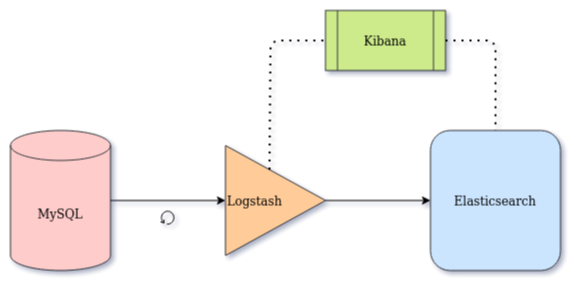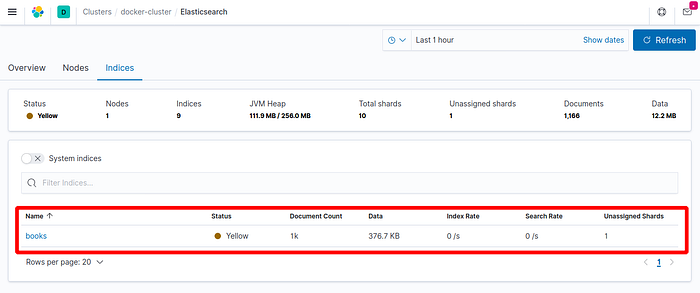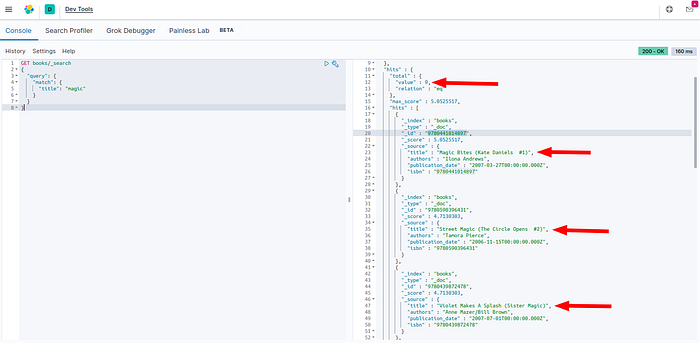How to synchronize Elasticsearch with MySQL
Using Logstash to create a data pipe linking Elasticsearch to MySQL in order to build an index from scratch and to replicate any changes occurring on the database records into Elasticsearch
https://towardsdatascience.com/how-to-synchronize-elasticsearch-with-mysql-ed32fc57b339
Quick Access Link
- Repository on GitHub: sync-elasticsearch-mysql.
Technology Stack
- MySQL as a main database (version 8.0.22)
- Elasticsearch as a text search engine (version 7.9.3)
- Logstash as a connector or data pipe from MySQL to Elasticsearch (version 7.9.3)
- Kibana for monitoring and data visualization (version 7.9.3)
- JDBC Connector/J (version 8.0.22)
Content
- Problem Statement
- Solution
- Benefits from using Logstash
- Use Cases- Implementing a proof of concept
- Creating a host directory for the project
- Setup a MySQL database
- Setup Elasticsearch and Kibana
- Setup Logstash to pipe data from MySQL to Elasticsearch:
* First Scenario — Creating an Elasticsearch index from scratch
* Second Scenario — Replicating changes on the database records to Elasticsearch- Conclusion
- Resources

Photo by Sébastien Jermer on Unsplash
Problem Statement
A common scenario for tech companies is to start building their core business functionalities around one or more databases, and then start connecting services to those databases to perform searches on text data, such as searching for a street name in the user addresses column of a users table, or searching for book titles and author names in the catalog of a library.
So far everything is fine. The company keeps growing and acquires more and more customers. But then searches start to become slower and slower, which tends to irritate their customers and makes it hard to convince new prospects to buy in.
Looking under the hood, the engineers realize that MySQL’s
FULLTEXTindexes are not ideal for text look-ups on large datasets, and in order to scale up their operations, the engineers decide to move on to a more dedicated and battle-tested text search engine.Enters Elasticsearch and its underlying Lucene search engine. Elasticsearch indexes data using an inverted document index, and this results in a blazing-fast full-text search.
A new challenge then comes in: How to get the data that is in a MySQL database into an Elasticsearch index, and how to keep the latter synchronized with the former?
Solution
The modern data plumber’s toolkit contains a plethora of software for any data manipulation task. In this article, we’ll focus on Logstash from the ELK stack in order to periodically fetch data from MySQL, and mirror it on Elasticsearch. This will take into consideration any changes on the MySQL data records, such as
create,update, anddelete, and have the same replicated on Elasticsearch documents.Benefits from using Logstash
The problem we are trying to solve here — sending data periodically from MySQL to Elasticsearch for syncing the two — can be solved with a Shell or Python script ran by a cron job or any job scheduler, BUT this would deprive us from the benefits otherwise acquired by configuring Logstash and its plugin-based setup:
- Although we focus on MySQL here, Logstash can ingest data from many sources, making it a centralized data input node.
- Logstash offers the possibility to parse, transform, and filter data on the fly, as it passes from source to destination.
- As for the input sources, there are many output destinations available — Elasticsearch being the go-to output.
- As part of the ELK Stack, everything will come together nice and smoothly later with Elasticsearch and Kibana for metrics and visualization.
Use Cases
We will cover two scenarios in the following steps:
- Creating an Elasticsearch index and indexing database records from scratch.
- Incremental update of the Elasticsearch index based on changes occurring on the database records (creation, update, deletion).
Implementing a proof of concept
Imagine you are opening an online library where avid readers can search your catalog of books to find their next reading. Your catalog contains millions of titles, ranging from scientific literature volumes to pamphlets about exotic adventures.
We will create an initial database table
bookswith a few thousands of records with book titles, authors, ISBN and publication date. We’ll use the Goodreads book catalog that can be found on Kaggle. This initial table will serve prototyping the use case (1) Building an index from scratch.We will create triggers on the table
booksthat will populate a journal tablebooks_journalwith all changes on thebookstable (e.g.create,update,delete). This means that whenever a record on thebookstable is created, updated, or deleted, this action will be recorded on thebooks_journaltable, and the same action will be done on the corresponding Elasticsearch document. This will serve prototyping the use case (2) Incremental update of the Elasticsearch index.We’ll prototype and test the above concepts by defining a micro-services architecture using docker-compose.

Architecture of this project — Image by Author
Prerequisites
Steps
Full source code can be found on GitHub at sync-elasticsearch-mysql.
- Start by creating a directory to host this project (named e.g.
sync-elasticsearch-mysql) and create a docker-compose.yaml file inside that directory with the following initial setup:version: "3"
services:
...
# Here will come the services definition
...2. Setup a MySQL database: Create a directory
data/where we’ll store MySQL dump files with the pre-cleaned books data for thebookstable, as well as the triggers for thebookstable (on create, update, and delete), and anew_arrivalstable with books we will add to our catalog to simulate new records, and the tablebooks_journal.You can find these dump files in the project repository. Please copy them to the
data/directory so that the MySQL container will add them to thebooksdatabase during the startup process.version: "3"
services:
# add this:
mysql:
image: mysql:8
container_name: sem_mysql
ports:
- 3306:3306
environment:
MYSQL_RANDOM_ROOT_PASSWORD: "yes"
MYSQL_DATABASE: books
MYSQL_USER: avid_reader
MYSQL_PASSWORD: i_love_books
volumes:
# Dump files for initiating tables
- ./data/:/docker-entrypoint-initdb.d/Note that storing usernames and passwords in plain text in your source code is not advised. The above is done for the sake of prototyping this project only and is not in any case a recommended practice.
To start MySQL and check that data has been added successfully, from you project’s directory run on a terminal:
docker-compose up -d mysql # -d is for detached mode# Once container started, log into the MySQL container
docker exec -it sem_mysql bash# Start a MySQL prompt
mysql -uavid_reader -pi_love_books# Check that tables have been loaded from dump files
use books;
show tables;
Listing of the available tables and a sample of the data — Image by Author
To show the triggers with a JSON-like formatting, use command:
SHOW TRIGGERS \G;# To exit the MySQL prompt press CTRL+D
# To logout from the MySQL container, press CTRL+DNow that we have our database properly set up, we can move on to the meat and potatoes of this project.
3. Setup Elasticsearch and Kibana: To setup Elasticsearch (without indexing any document yet), add this to your docker-compose.yaml file:
version: "3"
services:
...
elasticsearch:
image: docker.elastic.co/elasticsearch/elasticsearch:7.9.3
container_name: sem_elasticsearch
environment:
- discovery.type=single-node
- bootstrap.memory_lock=true
- "ES_JAVA_OPTS=-Xms512m -Xmx512m"
volumes:
- ./volumes/elasticsearch:/usr/share/elasticsearch/data
logging:
driver: "json-file"
options:
max-size: "10k"
max-file: "10"
kibana:
image: docker.elastic.co/kibana/kibana:7.9.3
container_name: sem_kibana
environment:
- "ELASTICSEARCH_URL=http://elasticsearch:9200"
- "SERVER_NAME=127.0.0.1"
ports:
- 5601:5601
depends_on:
- elasticsearchNote that the volumes definition is recommended in order to mount the Elasticsearch index data from the docker volume to your directory file system.
To get Elasticsearch and Kibana started, run the following from your project directory:
docker-compose up -d elasticsearch kibana # -d is for detached mode# To check if everything so far is running as it should, run:
docker-compose ps
After executing the above commands, 3 containers should be up and running — Image by Author
Let’s check if there is any index in our Elasticsearch node so far:
# On your terminal, log into the Elasticsearch container
docker exec -it sem_elasticsearch bash# Once logged in, use curl to request a listing of the indexes
curl localhost:9200/_cat/indicesIf Kibana is up and running, you’ll see a list of indices used for metrics and visualization, but nothing related to our books yet — and if Kibana hasn’t been started, the list of indices will be empty.

List of indexes created by Kibana — Image by Author
4. Setup Logstash to pipe data from MySQL to Elasticsearch:
To connect Logstash to MySQL, we will use the official JDBC driver available at this address.
Let’s create a Dockerfile (named
Dockerfile-logstashin the same directory) to pull a Logstash image, download the JDBC connector, and start a Logstash container. Add these lines to your Dockerfile:FROM docker.elastic.co/logstash/logstash:7.9.3# Download JDBC connector for Logstash
RUN curl -L --output "mysql-connector-java-8.0.22.tar.gz" "https://dev.mysql.com/get/Downloads/Connector-J/mysql-connector-java-8.0.22.tar.gz" \
&& tar -xf "mysql-connector-java-8.0.22.tar.gz" "mysql-connector-java-8.0.22/mysql-connector-java-8.0.22.jar" \
&& mv "mysql-connector-java-8.0.22/mysql-connector-java-8.0.22.jar" "mysql-connector-java-8.0.22.jar" \
&& rm -r "mysql-connector-java-8.0.22" "mysql-connector-java-8.0.22.tar.gz"ENTRYPOINT ["/usr/local/bin/docker-entrypoint"]Then add the following snippet to your docker-compose.yaml file:
version: "3"
services:
...
logstash:
build:
context: .
dockerfile: Dockerfile-logstash
container_name: sem_logstash
depends_on:
- mysql
- elasticsearch
volumes:
# We will explain why and how to add volumes belowLogstash uses defined pipelines to know where to get data from, how to filter it, and where should it go. We will define two pipelines: one for creating an Elasticsearch index from scratch (first scenario), and one for incremental updates on changes to the database records (second scenario).
Please check documentation for an explanation of each of the fields used in the pipeline definition:
- Input: JDBC Input Plugin
- Filter: Mutate
remove_field- Output: Elasticsearch Output Plugin
4.a. First Scenario — Creating an Elasticsearch index from scratch:
In your project directory, create a
volumesfolder (if not already created) then create a directory to host our Logstash configuration:mkdir -p volumes/logstash/configThen in this config directory, create a file
pipelines.ymlcontaining:- pipeline.id: from-scratch-pipeline
path.config: "/usr/share/logstash/pipeline/from-scratch.conf"We then create a folder
pipelineto host our pipelines definitions:mkdir volumes/logstash/pipelineand there create a file
from-scratch.confwith the following content:input {
jdbc {
jdbc_driver_library => "/usr/share/logstash/mysql-connector-java-8.0.22.jar"
jdbc_driver_class => "com.mysql.jdbc.Driver"
jdbc_connection_string => "jdbc:mysql://mysql:3306"
jdbc_user => "avid_reader"
jdbc_password => "i_love_books"
clean_run => true
record_last_run => false
statement_filepath => "/usr/share/logstash/config/queries/from-scratch.sql"
}
}filter {
mutate {
remove_field => ["@version", "@timestamp"]
}
}output {
# stdout { codec => rubydebug { metadata => true } }
elasticsearch {
hosts => ["http://elasticsearch:9200"]
index => "books"
action => "index"
document_id => "%{isbn}"
}
}We define where to find the JDBC connector in
jdbc_driver_library, setup where to find MySQL injdbc_connection_string, instruct the plugin to run from scratch inclean_run, and we define where to find the SQL statement to fetch and format the data records instatement_filepath.The filter basically removes extra fields added by the plugin.
In the output, we define where to find the Elasticsearch host, set the name of the index to
books(can be a new or an existing index), define which action to perform (can beindex,create,update,delete— see docs), and setup which field will serve as a unique ID in thebooksindex — ISBN is an internationally unique ID for books.To add the SQL query referenced by
statement_filepath, let’s create a folderqueries:mkdir volumes/logstash/config/queries/Then add file
from-scratch.sqlwith as little as:SELECT * FROM books.booksto get our index built with all the records available so far in our
bookstable. Note that the query should NOT end with a semi-colon (;).Now to mount the configuration files and definitions created above, add the following to your docker-compose.yaml file:
version: "3"
services:
...
logstash:
...
volumes:
- ./volumes/logstash/pipeline/:/usr/share/logstash/pipeline/
- ./volumes/logstash/config/pipelines.yml:/usr/share/logstash/config/pipelines.yml
- ./volumes/logstash/config/queries/:/usr/share/logstash/config/queries/Note that
volumesdirectives are a way to tell Docker to mount a directory or file inside the container (right hand side of the :) onto a directory or file on your machine or server (left hand side of the :). Checkout the official Docker Compose documentation onvolumes.Testing
In order to test the implementation for this first scenario, run on your terminal:
docker-compose up logstashIf the run is successful, you will see a message similar to
Logstash shut downand the container will exit with error code 0.Now head to Kibana on you browser (to this link for example) and let’s start playing around to see if we have a
booksindex and how we can search for books.
The books index has been successfully created and contains 1k documents — Image by Author
In the Dev Tools panel, you can run custom queries to fetch documents by field value. For example, let’s search for books with the word “magic” in their title. Paste this query on the Dev Tools console:
GET books/_search
{
"query": {
"match": {
"title": "magic"
}
}
}We get 9 documents:

Searching for books containing the word “magic” in their title — Image by Author
Image by Giphy
4.b. Second Scenario — Replicating changes on the database records to Elasticsearch:
Most of the configuring and tweaking has been done in the previous part. We will simply add another pipeline that will take charge of the incremental update (replication).
In the file
volumes/logstash/config/pipelines.yml, add these two line:- pipeline.id: incremental-pipeline
path.config: "/usr/share/logstash/pipeline/incremental.conf"In the same file, you may want to comment out the two previous lines related to the “from-scratch” part (first scenario) in order to instruct Logstash to run this incremental pipeline only.
Let’s create a file
incremental.confin the directoryvolumes/logstash/pipeline/with the following content:input {
jdbc {
jdbc_driver_library => "/usr/share/logstash/mysql-connector-java-8.0.22.jar"
jdbc_driver_class => "com.mysql.jdbc.Driver"
jdbc_connection_string => "jdbc:mysql://mysql:3306"
jdbc_user => "avid_reader"
jdbc_password => "i_love_books"
statement_filepath => "/usr/share/logstash/config/queries/incremental.sql"
use_column_value => true
tracking_column => "journal_id"
tracking_column_type => "numeric"
schedule => "*/5 * * * * *"
}
}filter {
if [action_type] == "create" or [action_type] == "update" {
mutate { add_field => { "[@metadata][action]" => "index" } }
} else if [action_type] == "delete" {
mutate { add_field => { "[@metadata][action]" => "delete" } }
}mutate {
remove_field => ["@version", "@timestamp", "action_type"]
}
}output {
# stdout { codec => rubydebug { metadata => true } }
elasticsearch {
hosts => ["http://elasticsearch:9200"]
index => "books"
action => "%{[@metadata][action]}"
document_id => "%{isbn}"
}
}We see a few extra parameters compared to the previous pipeline definition.
The
scheduleparameter has a cron-like syntax (with a resolution down to the second when adding one more value the left), and uses the Rufus Scheduler behind the scene. Here we instruct Logstash to run this pipeline every 5 seconds with*/5 * * * * *.The website crontab.guru can help you read crontab expressions.
During each periodic run, the parameter
tracking_columninstructs Logstash to store thejournal_idvalue of the last record fetched and store it somewhere on the filesystem (See documentation here forlast_run_metadata_path). In the following run, Logstash will fetch records starting fromjournal_id + 1, wherejournal_idis the value stored in the current run.In the
filtersection, when the database action type is “create” or “update”, we set the Elasticsearch action to “index” so that new documents get indexed, and existing documents get re-indexed to update their value. Another approach to avoid re-indexing existing documents is to write a custom “update” script and to use the “upsert” action. For “delete” actions, the document on Elasticsearch gets deleted.Let’s create and populate the file
incremental.sqlin directoryvolumes/logstash/config/queries/with this query:SELECT
j.journal_id, j.action_type, j.isbn,
b.title, b.authors, b.publication_date
FROM books.books_journal j
LEFT JOIN books.books b ON b.isbn = j.isbn
WHERE j.journal_id > :sql_last_value
AND j.action_time < NOW()
ORDER BY j.journal_idTesting
Let’s have a look at the table
books.new_arrival. It contains books that just got delivered to us and we didn’t have time to add them to our mainbooks.bookstable.Result of “SELECT * FROM books.new_arrival;” — Image by Author
As we can see, none of the books in that table are in our Elasticsearch index. Let’s try with the 3 book in the table above “The Rocky Road to Romance (Elsie Hawkins #4)”, ISBN 9780060598891:
Search for ISBN 9780060598891 returns empty result — Image by Author
Now let’s transfer that book from the new arrivals table to our main
bookstable:INSERT INTO books
SELECT * FROM new_arrival WHERE isbn = 9780060598891;Running the same search on Elasticsearch, we are happy to see that the document is now available:
Now ISBN 9780060598891 is available on the Elasticsearch index — Image by Author
The sync is working!
Let’s test with an update of the same ISBN:
UPDATE books
SET title = "The Rocky what ??"
WHERE isbn = 9780060598891;Updates on the database records are successfully replicated to Elasticsearch documents — Image by Author
…and a delete of the same ISBN:
DELETE from books WHERE isbn = 9780060598891;A record deleted from the database will also be removed from the Elasticsearch index — Image by Author Image by Giphy
Conclusion
We managed to get a proof of concept up and running in a short amount of time of how to index data into Elasticsearch from a MySQL database, and how to keep Elasticsearch in sync with the database.
The technologies we used are a gold standard in the industry and many businesses rely on them daily to serve their customer, and it’s very likely that many have encountered or will encounter the same problem we solved in this project.
Get in touch
Shoot me a message! I am on these social platforms:
- Twitter: https://twitter.com/redouaneoachour
- LinkedIn: https://www.linkedin.com/in/redouane-achouri/
- GitHub: https://github.com/redouane-dev
If you find this post helpful, feel free to share it and follow to get my latest articles!
Integration of ElasticSearch With MySQL
https://www.baeldung.com/ops/elasticsearch-mysql
refer
https://github.com/rayjasson98/docker-mysql-elk
https://github.com/Colibri-code/ElasticSearch-Docker-MySql
https://github.com/zhangjunjie6b/mysql2elasticsearch
https://github.com/r13i/sync-elasticsearch-mysql
标签:index,MySQL,How,books,Elasticsearch,mysql,data From: https://www.cnblogs.com/lightsong/p/18616032